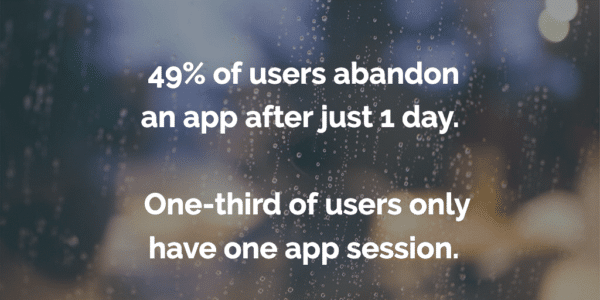APAC leads in app downloads and usage but…
High app abandonment means mobile marketers in Asia Pacific need a plan to ensure user retention.
APAC accounts for two-thirds (64%) of all app downloads globally.
In Southeast Asia, smartphones are practically another appendage. 90% of consumers use their smartphone to connect, spending more than 4 hours in different apps every day – an hour more on average than other regions in the world.
That’s good news – there’s no end in sight for app demand. The flip side is that there’s too much choice for consumers with limited attention spans.
This has created a mobile app abandonment crisis. Criteo research shows that 49% of users abandon their latest app after just one day. One-third of users only have one app session.

App marketers often rely on two proven tactics to reengage users: push notifications and email marketing programs. Both have their pros and cons.
The Balancing Act of Push Notifications
Push notifications are a direct line to consumers who have already downloaded your app. But it’s a delicate balance. Too many notifications and a user may drop your app.
Finding the sweet spot requires careful calibration between opt-ins, relevancy, and frequency.
Pros:
- Visibility. Immediate, personalized notifications encourage users to take or finish an action.
- Timely and customized. You can send notifications based on relevant updates, cart reminders, games completed, or location.
- High conversion rates. Quick response – 40% of users interact with push notifications within an hour.
Cons:
- Users must opt in. Nearly one-third of users disable push notifications.
- Opting out or ignoring push notifications is getting easier. Updates to notification settings – like provisional authorization, push notification groupings, and notification center features – mean users have options for de-prioritizing your notifications.
- Most people prefer emails or ads. Nearly half of users (41%) say they prefer to receive marketing messages via email or mobile ads, while fewer than one in five (18%) prefer push notifications, according to eMarketer.
Rising Engagement in Email Marketing
Email engagement is on the rise globally with 78% of marketers reporting an increase in engagement in 2019.
Permission-based emails drive users back to your app. And, in mobile-first Asia Pacific markets, optimizing email campaigns for mobile devices is critical.
Pros:
- Cost-efficient. Email service providers (ESPs) offer everything from do-it-yourself platforms to robust solutions that plug into CRM platforms. Find one that suits your needs and budget.
- Good for user acquisition. 81% of SMBs still rely on email as their primary customer acquisition channel. Delivering valuable content can strengthen relationships with your app customers.
- Drive re-engagement. Email isn’t just for app re-engagement. Win-back emails result in nearly half (45%) of lapsed customers interacting with your brand again.
Cons:
- Inbox position. The fight for the top-of-the-inbox is competitive. Gmail’s sorting tool, for example, may force your email into the less important “everything else” section – or worse, the spam folder.
- Privacy compliance. Maintaining an email database requires an understanding of privacy regulations. For example, the EU’s GDPR requires marketers to obtain “freely given, specific, informed, and unambiguous consent” from users.
- Email validation. Stricter opt-in rules mean users who don’t validate their emails are a no-go.
Takeaway: Notifications and email are useful tools for mobile app re-engagement programs, but each has its limitations. Next up, learn how app retargeting [link] can be used alongside email and push notifications to create a personalized, targeted channel that drives higher engagement and conversions.
“You have to live with the customer throughout their journey. You want to be able to get the right users to install your app, and then bring them back, engage them, get them excited, build more loyalty and ultimately get them to buy things.”
Alex Valle, VP of products, Criteo
To learn more, download our full guide, The Ultimate Guide to App Retention or visit Criteo’s mobile app advertising platform page.
This is the second part of a three-part series of posts on mobile app engagement in Asia Pacific. Read our articles on the app abandonment issue and the power of retargeting to bring users back to your app.






















